Last Updated November 10, 2021
Having a personal finance binder is a fantastic way to organize your finances. I created a Personal Finance Binder to help you: 1) save more money; 2) reduce expenses, and 3) pay off debt. Find out how to make a financial binder of your own and what supplies you’ll need.
Before you get started, be sure to buy your Personal Finance Binder here.
Why You Should Have A Financial Binder
Finding the right budgeting method can be tough. I currently use Excel spreadsheets (I love the calculators, charts, and graphs), but I felt that I also needed a “paper component” to keep everything organized. Therefore, I put together a financial binder to use in conjunction with my spreadsheets. It’s called the Personal Finance Binder.
A financial binder is how you can keep all of your important financial documents together and organized. When you have all your financial documents in one place, it makes it easy for you to keep track of everything.
Benefits Of A Financial Binder

A financial binder is a great way to organize your finances and get control of your money. The Personal Finance Binder will help you:
- Stay organized;
- Pay off debt;
- Save money.
- Set financial goals;
- Budget your money;
- Track your income; and
- Change the way you think about money so you can have more money.
This binder is everything you need to manage your money better.
What’s Included In The Personal Finance Binder
This binder is a digital download of over 55 pages worth of printables. Here’s what’s included:
- Cover Page
- Table of Content
- About Me
- Money Mindset Assessment
- Net Worth Worksheet
- Financial Goals
- Yearly Financial Goals
- Monthly Financial Goals
- Weekly Financial Goals
- Bill Payment Calendar
- Weekly Planner
- Daily Planner
- Monthly Financial Goals Reflection
- Habits Tracker
- Bank Account Information
- Passwords To Remember
- Monthly Budget (Filled)
- Monthly Budget (Unfilled)
- Paycheck Budgeting
- Cash Envelope Templates and Spending Tracker Insert
- Cash Envelope Overview
- Budget Categories Checklist
- Income Tracker
- Annual Expense Tracker (Filled)
- Annual Expense Tracker (Unfilled)
- Annual Bill Payment Checklist
- Daily Expense Tracker
- Upcoming Expenses Tracker
- Automatic Bill Payment Tracker
- Bill Payment Tracker
- Debt Avalanche/Snowball Worksheet
- Debt Payment Tracker
- Debt Worksheet
- Automatic Savings Tracker
- Savings Tracker
- Debt/Savings Thermometer
- Sinking Fund Worksheet
- 31 Day Savings Challenge
- 52 Week Money Savings Challenge
- No Spend Challenge
- Yearly Financial Goals Reflection
- Stock Investments Tracker
- Donations Tracker
- Tax Deductions
- Birthday Gift/Special Day Planner
- Black Friday Planner
- Christmas Shopping Planner
- Weekly Meal Planner
- Holiday Meal Planner
It also comes with a user guide that explains exactly how to use every printable that comes in this binder. You can mix and match the pages to make the binder perfect for you. If you happen to find a page that does not work for your situation, just remove it from your binder.
How To Create A Financial Binder
There are certain supplies you’re going to need first to set up your financial binder. Here’s a list of all the things you’ll need:
Binder
The first thing you need to create a financial binder is a binder. Determine how you plan to use your binder to help you decide what size binder you should purchase.
If you plan to use your binder only for your finances, then you can use a small binder (1 inch) or a medium binder (2 inches). If you plan to use your binder more as a home management binder, where your finances will just be one section of your binder, then you should use a large binder (3 inches).
3 Hole Punch
You need a 3 hole punch in order to fit your printables into your binder.
Dividers
Dividers are great to help you separate the different sections of your binder.
For example, you might have a section for financial goal setting, savings, or paying off debt. You may also want each month to be a different section. Another option you can use is sticky repositionable tabs as a way to divide your binder.
Here’s a picture of how I divide my Personal Finance Binder into different sections:
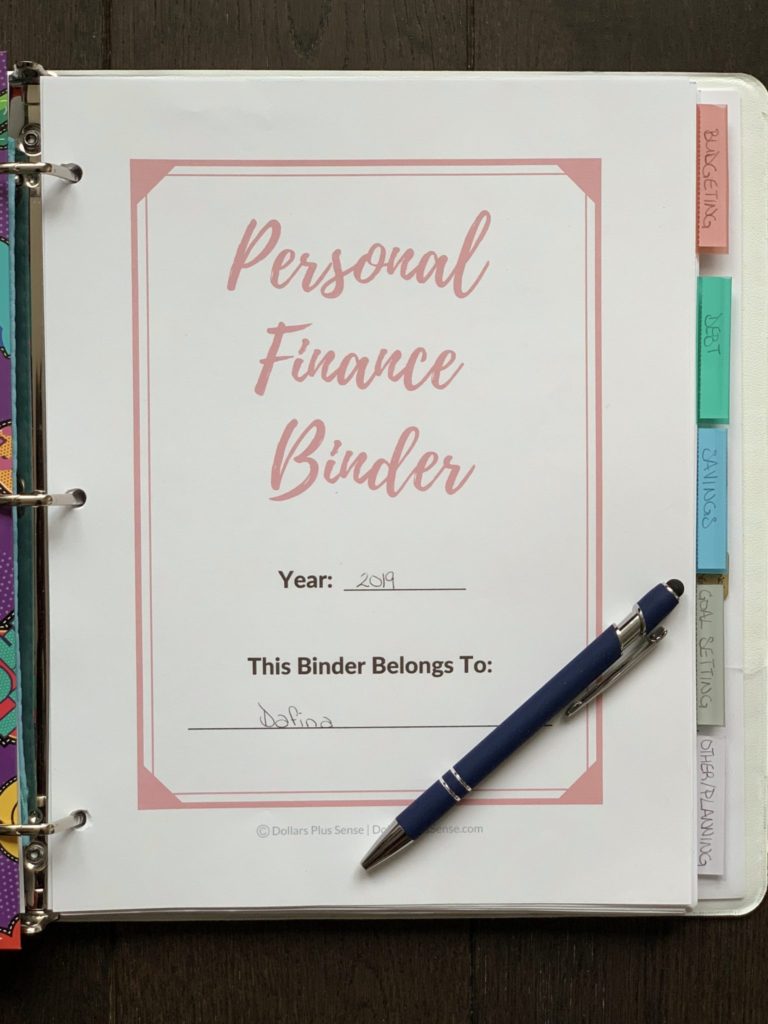
Folder
I recommend you get a folder to hold your statements or bills.
For example, I use my folder to store statements until I’m ready to file them, and store my bills until I’m ready to pay them. You can also get dividers that have pockets so they have a dual purpose.
Here’s how my Personal Finance Binder is organized:
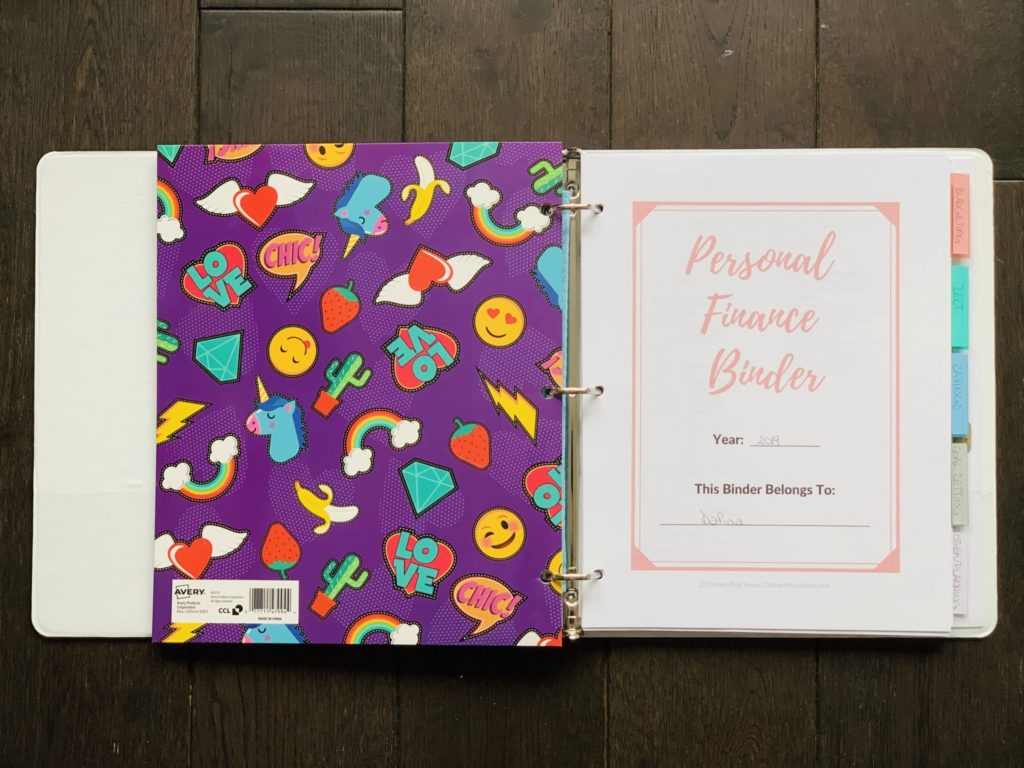
I normally keep my folder in the front.
Pencil Pouch
Finally, you need a pencil pouch to hold all your supplies. Keep things such as your pens, pencils, whiteout, erasers, highlighters, checkbook, stamps, and address labels in your pencil pouch.
Again, here’s a picture of my Personal Finance Binder:
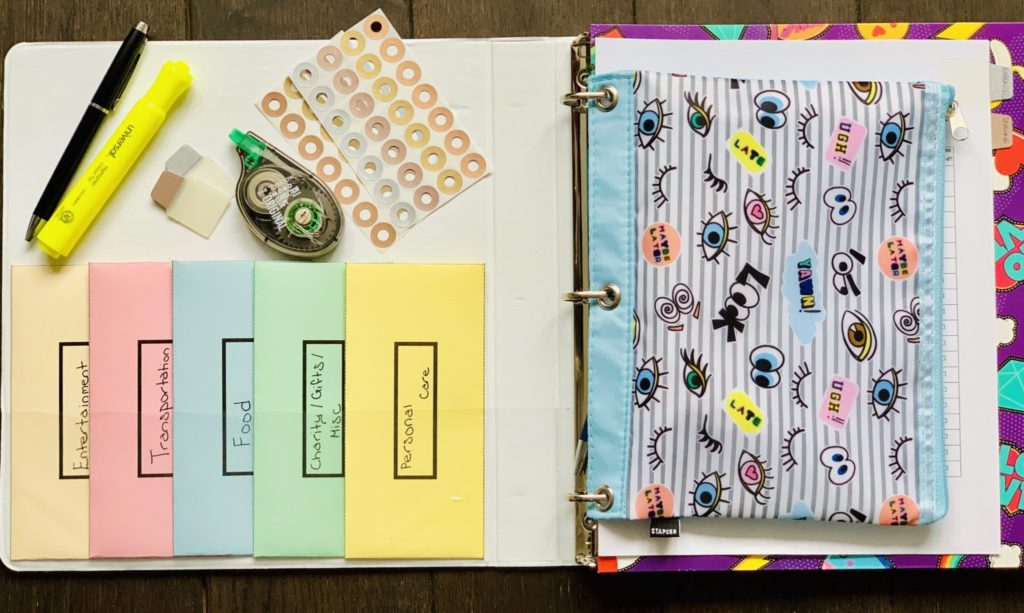
How I Organize My Personal Finance Binder
I’ve divided my Personal Finance Binder into 5 sections. My section breakdown is as follows:
- Goal Setting
- Budgeting
- Debt
- Savings
- Other/Planning
You can also divide your budget binder by month as another option.
If this is your first time setting up a financial binder, you may be asking yourself, “Where should I begin?” I recommend you start by setting some financial goals.
Section 1: Goal Setting
This section of my budget binder is where I focus on all my financial goals. It is important to set financial goals and track your progress regularly. People who identify their goals and work towards them usually accomplish their goals and accomplish them quicker.
Therefore, I keep the following printables in this section (in this order) of my financial binder:
- Money Mindset Worksheet
- Financial Goals Worksheet
- Yearly Financial Goals
- Monthly Financial Goals
- Monthly Habit Tracker
- Weekly Financial Goals
- Monthly Financial Goals Reflection
- Net Worth Worksheet
- Yearly Financial Goals Reflection
Here’s a look at some of the printables from the Personal Finance Binder that I keep in this section:
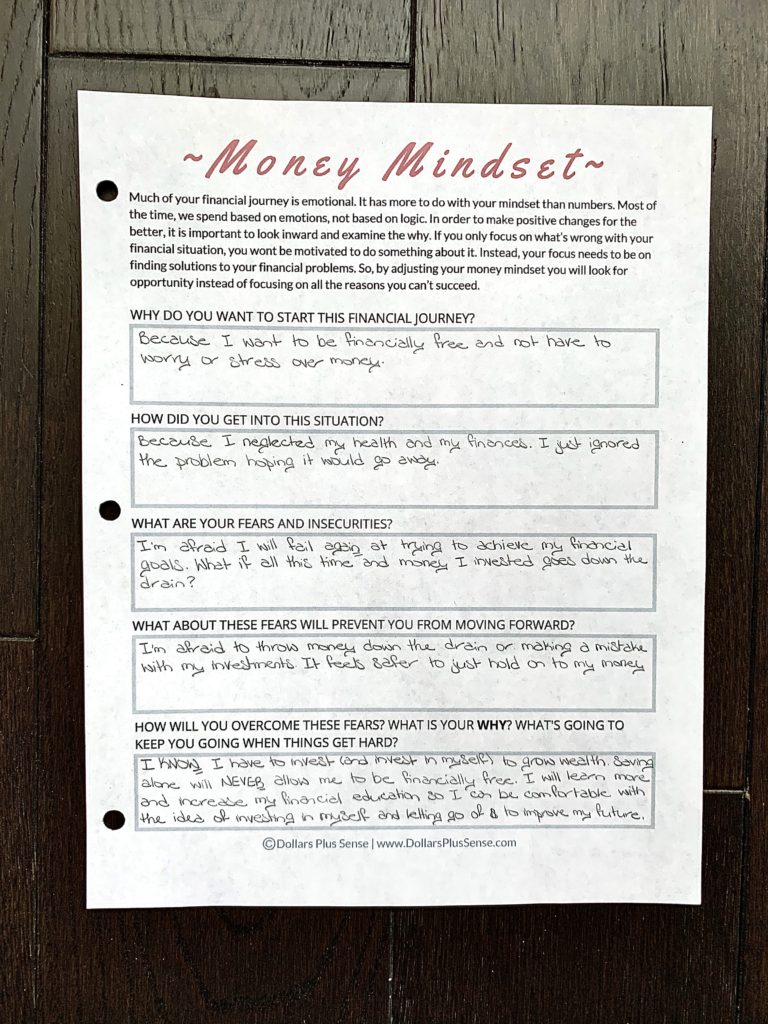
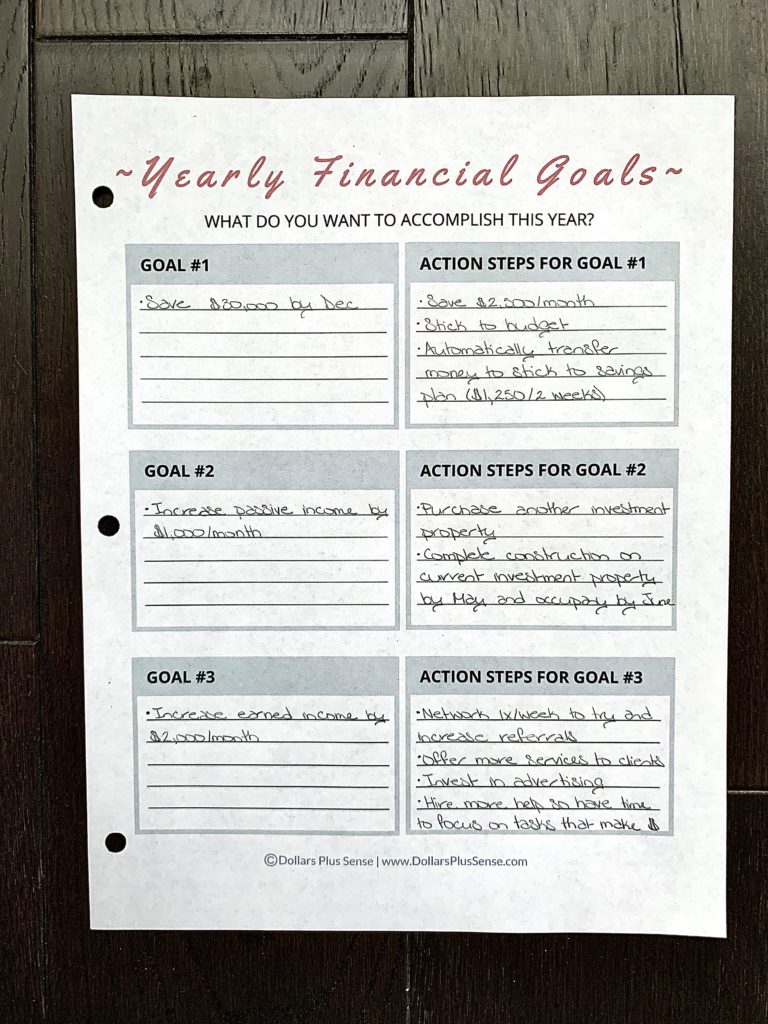
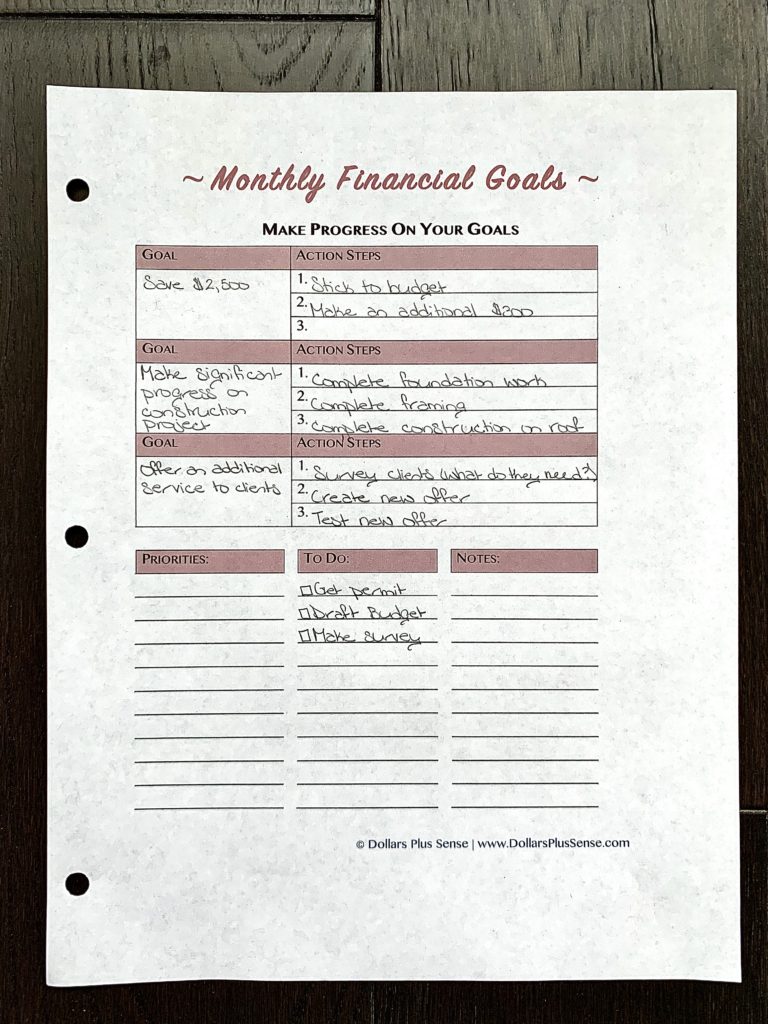
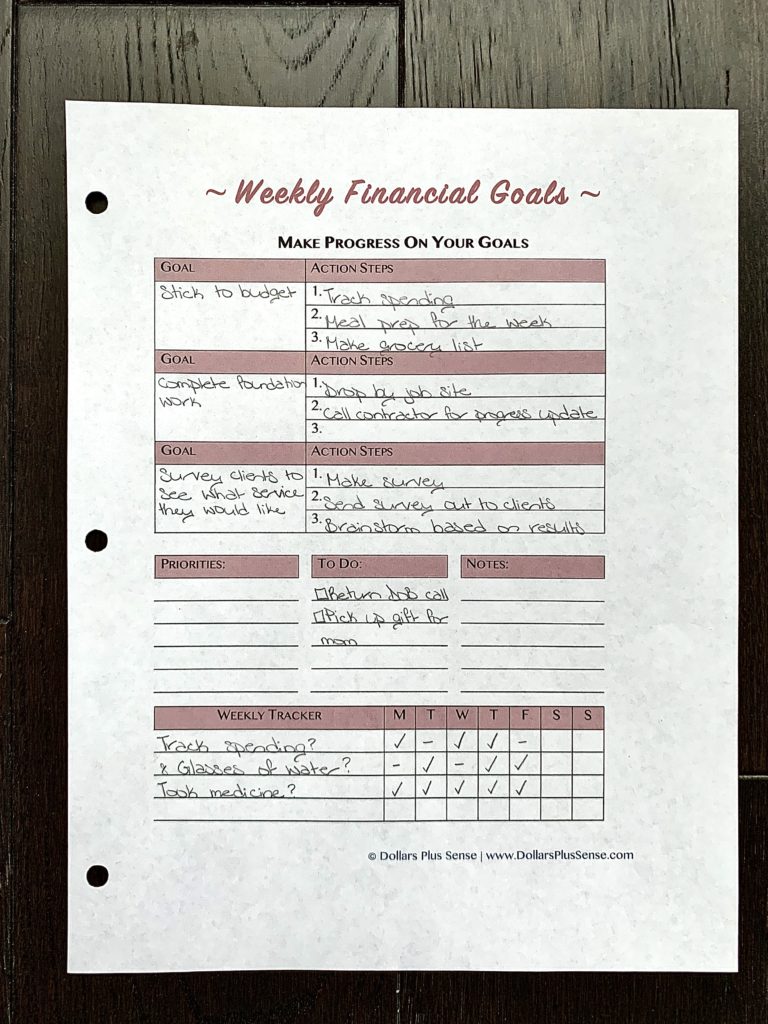

After you make your financial goals, you should calculate your net worth every quarter and go over your financial goals every month. This will help to see if you’re still on track to achieve your goals. If not, you know you need to make some adjustments.
Section 2: Budgeting
Once you have your financial goals set up, the next logical step is to set up a budget. Therefore, the second section of my financial binder is budgeting.
In this section of my financial binder, I keep the following printables (in this order):
- Income Tracker
- Daily Expense Tracker
- Budgeting Categories List
- Monthly Budget (filled and unfilled)
- Paycheck Budget
- Annual Expense Tracker (filled and unfilled)
- Annual Bill Payment Checklist
- Upcoming Expenses
- Automatic Bill Pay Tracker
- Bill Payment Tracker
- Cash Envelope Overview
- Cash Envelopes Templates and Tracker Inserts

Of course, I don’t use every printable in this section every month, but I keep these printables grouped together in the same section of my monthly budget planner anyway. For example, I may choose not to use the Monthly Budget and use the Paycheck Budget instead.
If this is your first time trying to create a budget, follow these 5 simple steps to make a budget that WORKS:
- Determine your net income (take-home pay)
- Determine your monthly expenses
- Determine how much you want to allocate to each spending category
- Track and review your spending
- Make adjustments where necessary.
Here’s an example of what my monthly budget printable looks like:
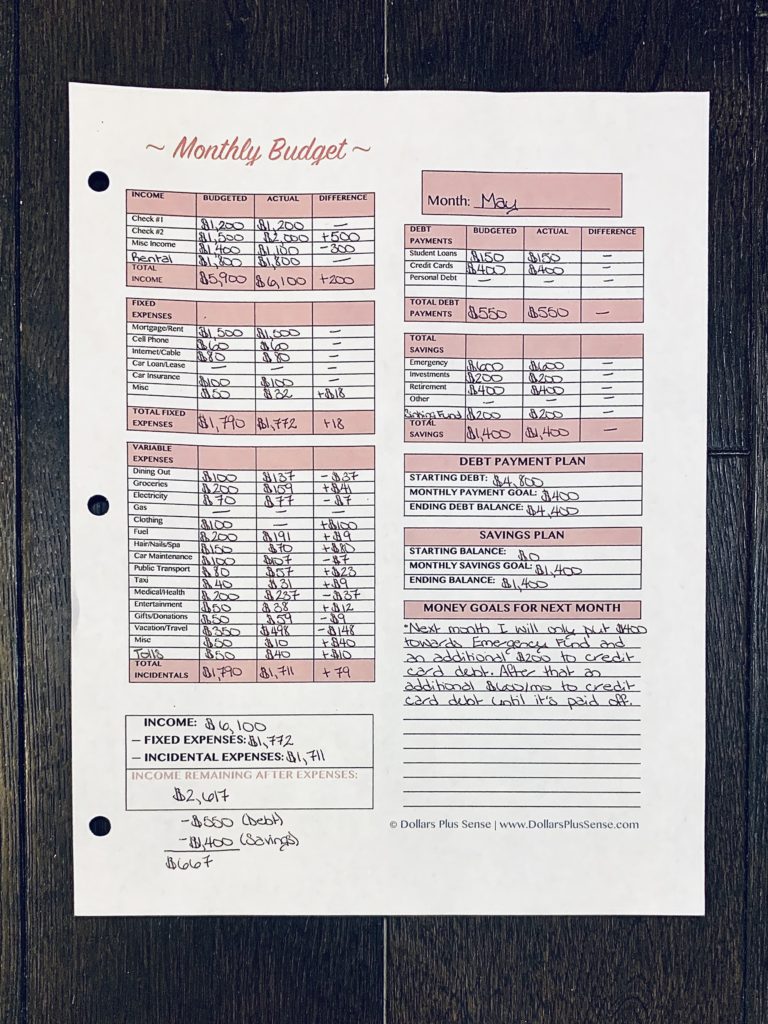
You can get a free copy of this monthly budget printable by clicking the link.
Once you make your budget, take a minute to sit down and compare the actual expenses versus what you had in your budget. This will show you where you did well and where you may need to improve. You should not let a month pass without reviewing your budget.
Remember, you’re not going to get your budget perfect the first time and you will need to make adjustments to find a perfect system for you.
If you prefer to use a budget spreadsheet instead, check out my Monthly and Yearly Budget Spreadsheets. As I said before, I currently use spreadsheets to budget my money because I love the calculators, charts, and graphs, but I also use them in conjunction with my Personal Finance Binder to keep everything organized.
Finally, at the end of each month, I fill out the Annual Expense Tracker to compare how I did from month to month.
For example, if you overspent on dining out in January, you can see if you made up the difference by spending less in February or March.
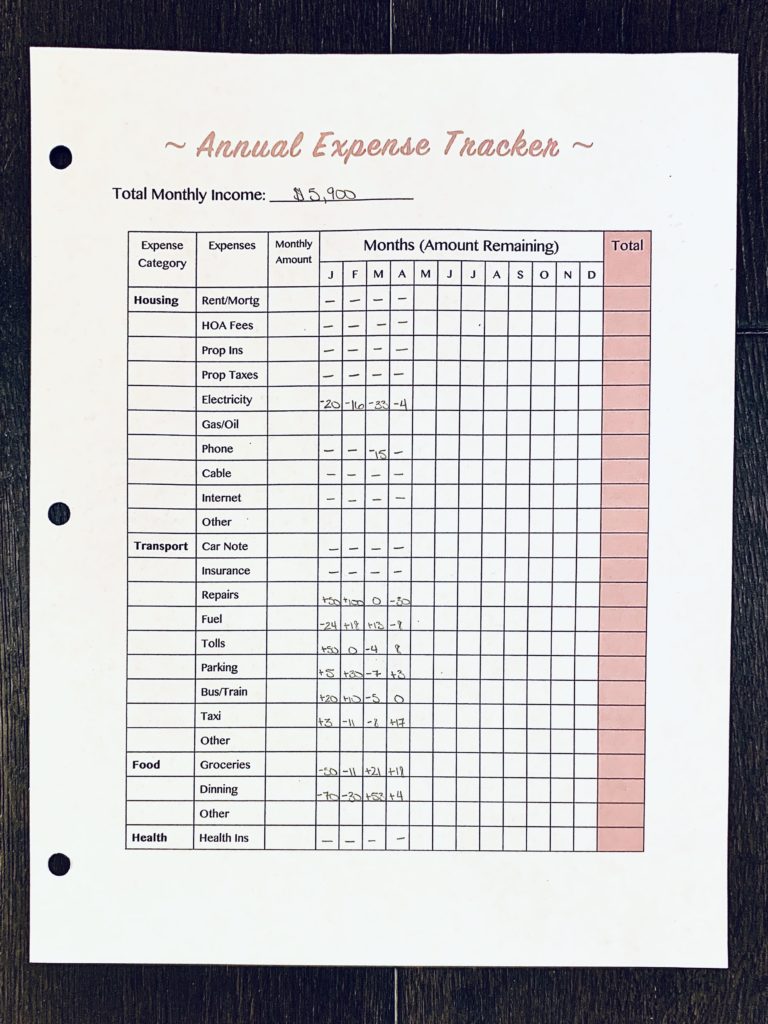
Section 3: Debt
The next section is where I keep track of my debt.
In this section, I keep the following printables:
- Debt Worksheet
- Debt Avalanche/Snowball Worksheet
- Debt Payoff Tracker
I use a Debt Worksheet to help me make a debt repayment plan and keep track of my debt payment.

When using the Debt Worksheet, follow these steps:
- List out all of your current debts with their interest rate, minimum payment, and total balance owed.
- Figure out which debts you want to pay off first using the Debt Worksheet found in your Personal Finance Binder. For me, I’m using the Debt Avalanche Method, which means I’m paying off my debt with the highest interest rate first.
- Once you figure out which debts you want to pay off first, use the Debt Avalanche/Snowball Worksheet to keep track of your progress as you pay down your debt.
If you prefer using a spreadsheet to keep track of your debt payoff journey, try using my Debt Payoff Spreadsheets. These spreadsheets will help you figure out the best debt payoff method for you so you can pay off your debt FAST!
Finally, I also use a Debt Payoff Tracker to help me keep track of my progress. This printable is a nice visual that makes it easy for you to see your progress and motivates you to keep going.
Here’s an example of what the Debt Payoff Tracker looks like:

You can get a copy of my Debt Worksheet, Debt Payoff Tracker, and Monthly Budget printable in my FREE Resource Library. My Resource Library is loaded with more than 20 pages of easy-to-print worksheets, checklists, and money-saving tips.
- Related Article: My Simple 5-Step Formula For How I Saved $300,000 In 4 Years
Section 4: Savings
This section of my budget binder is where I focus on my savings goals. I keep the following printables:
- Automatic Savings Tracker
- Savings Tracker
- Savings/Debt Thermometer
- Sinking Fund Worksheet
- 31-Day Money Savings Challenge
- 52-Week Money Savings Challenge
- No Spend Challenge Calendar
- Stock Investments Tracker
These printables make it very easy for me to keep track of all my savings goals.
Here’s a look at some of the printables from the Personal Finance Binder that I keep in this section:
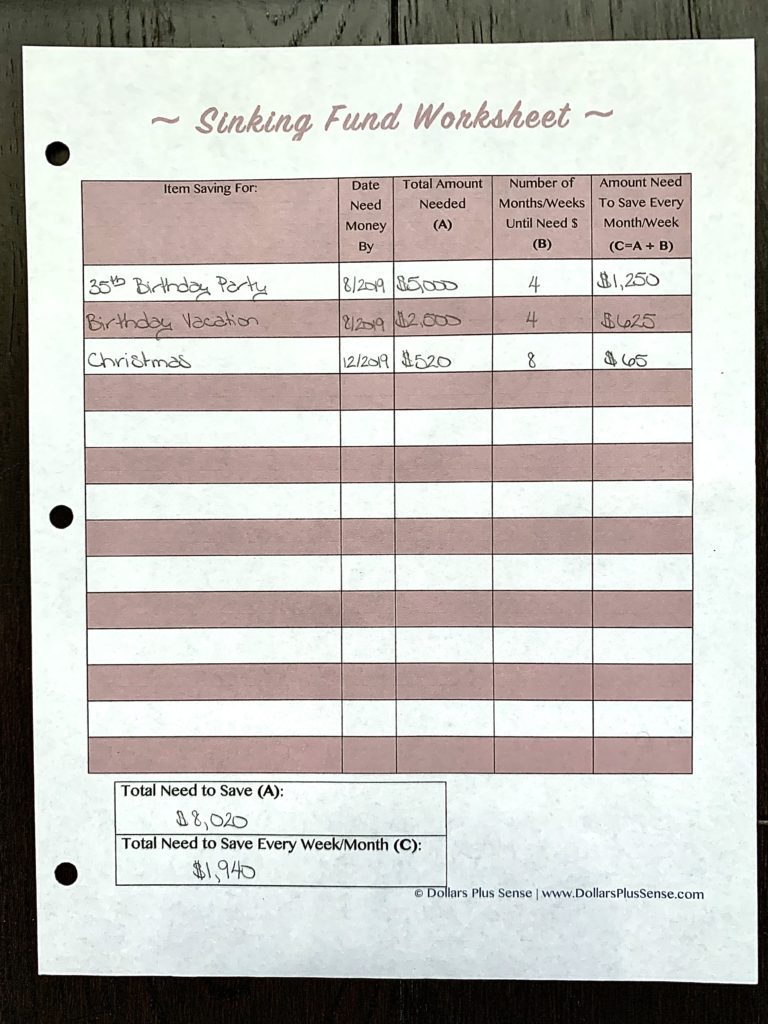
The Sinking Fund Worksheet will help you map out all the savings goals you have and how much you need to save for that goal.
For example, in 2019 I had a major birthday trip and party I wanted to save for. I also like to prepare for Christmas and any other holidays or events in advance. So, the picture above is what my Sinking Fund Worksheet looked like last year so I could properly prepare for these expenses.
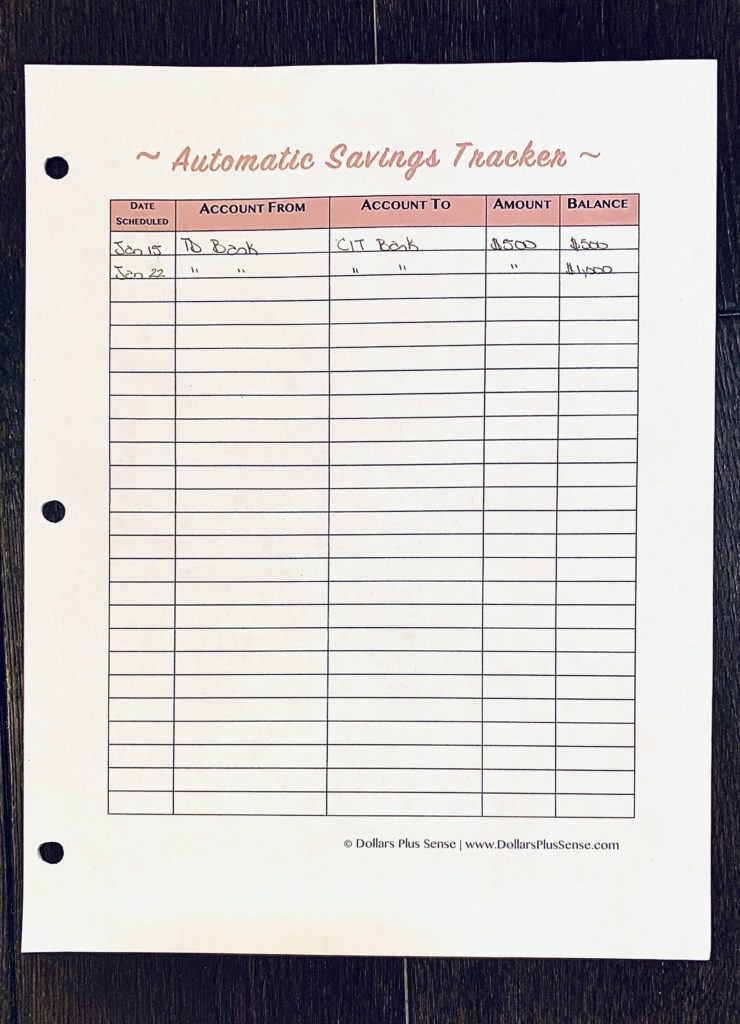
One of my secrets to saving so much money is I automate my savings. The Personal Finance Binder has an Automatic Savings Tracker to help you with this. This worksheet will help you track all of your automatic savings so you’re more organized.
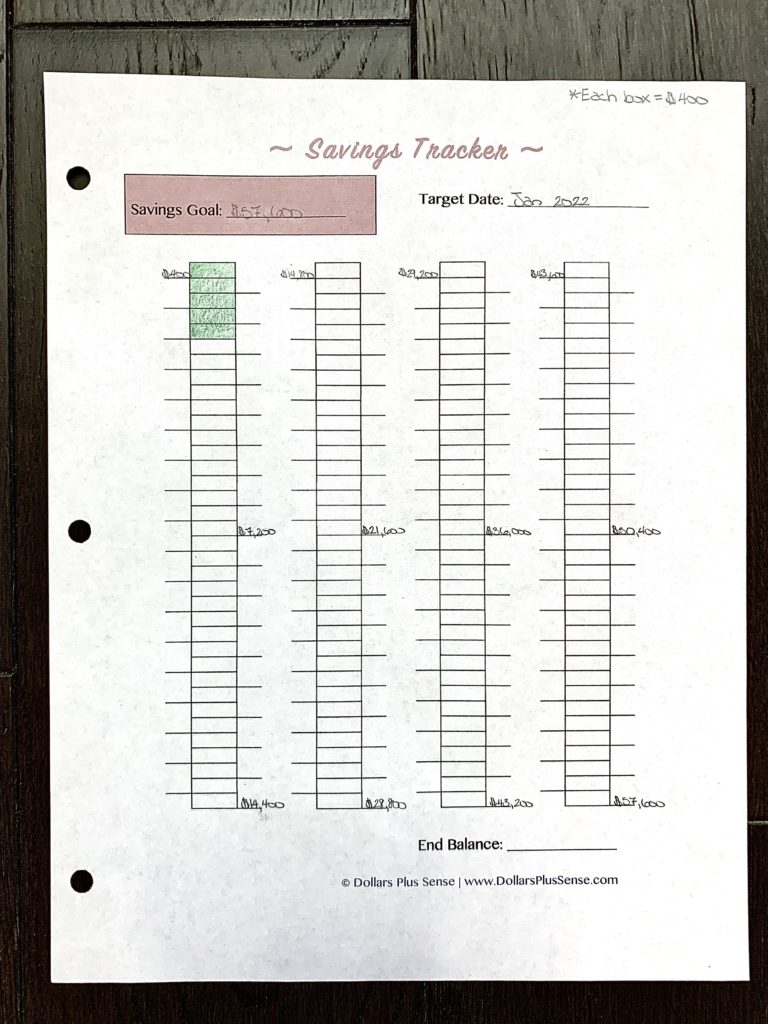
The Savings Tracker is a fun visual to view your savings progress. I don’t know if you’re like me, but coloring in each box keeps me motivated to keep going because I can actually see the progress I’m making.
Section 5: Other/Planning
The last section of my budget binder is where I focus on any seasonal planning I need to do or other miscellaneous financial business. In this section I keep the following printables:
- Bank Account Information
- Passwords To Remember
- Donations Tracker
- Tax Deductions Tracker
- Black Friday/Cyber Monday Shopping Plan
- Christmas Shopping Plan
- Weekly Meal Planner
- Holiday Meal Planner
Here’s a look at some of the printables from the Personal Finance Binder that I keep in this section:


If you want to know more about how you can save more money with the Personal Finance Binder and exactly how I use it, you can read my detailed article “Save More Money With The Ultimate Personal Finance Binder.”
Summary
I use my Personal Finance Binder for budget and financial organization. A financial binder is perfect for you if you have a hard time organizing your finances, you’re tired of stressing about money, or you just don’t know where to start on your financial journey.
This list of supplies should help you get started with setting up your financial binder. If you haven’t done so already, you can get your Personal Finance Binder here.
Related Articles:
- How To Use A Monthly and Yearly Household Budget Spreadsheet
- How Being A Penny Pincher Is Costing You
- 10 Proven Reasons Budgeting Is Important
If you want to remember this article, pin it to your favorite Pinterest board.
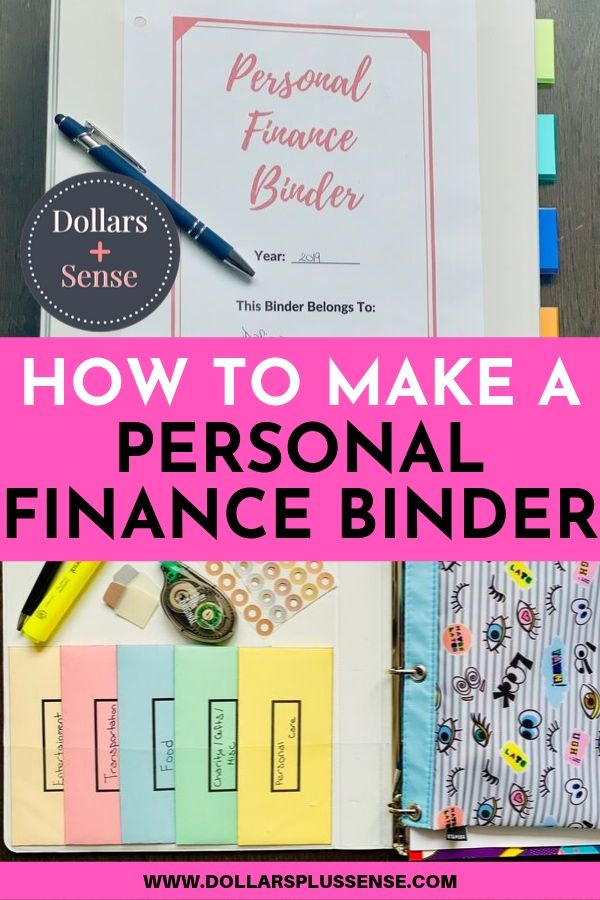












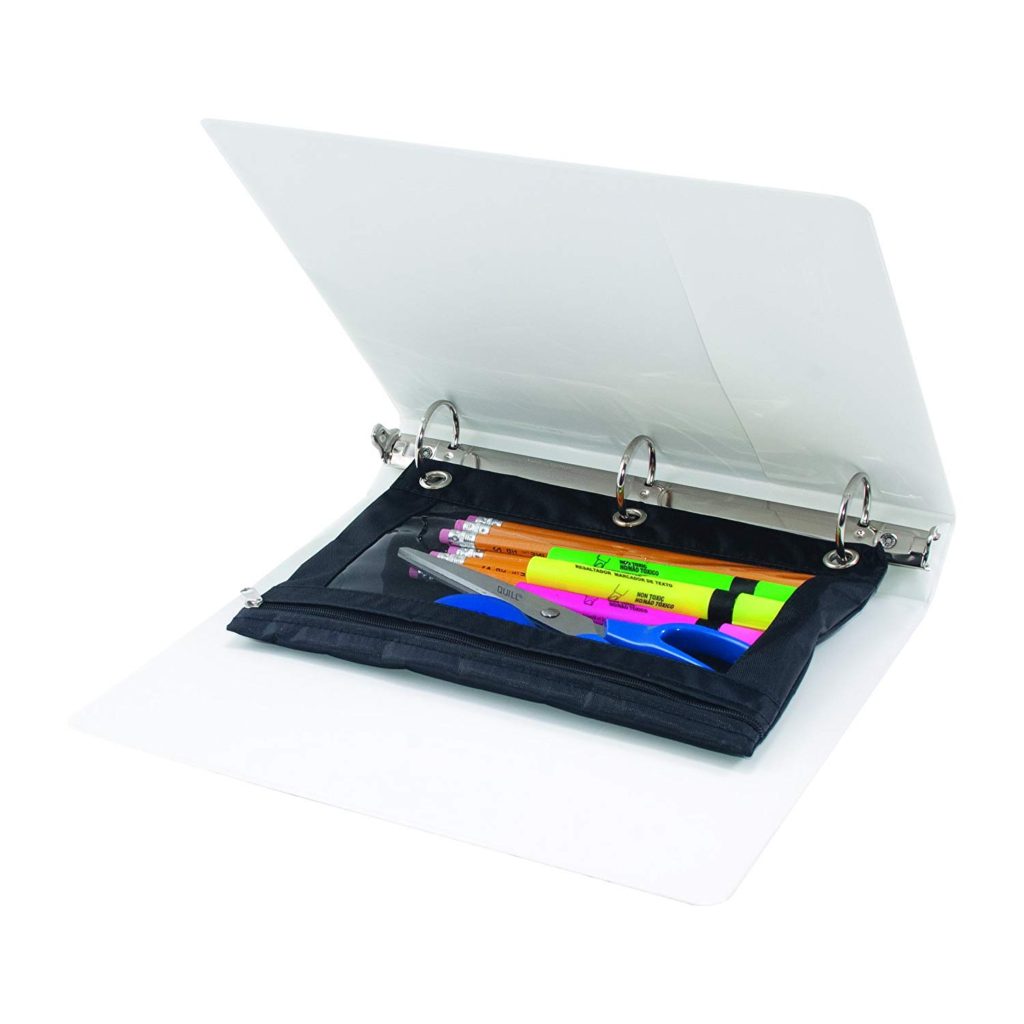


I don’t unremarkably comment but I gotta tell thankyou for the post on this special one : D.
Thanks Emiko!
This post has been so helpful! I’m trying to get control of my spending while building a website. Thanks so much for this information.
Thanks Monica! I’m glad I was able to help 🙂